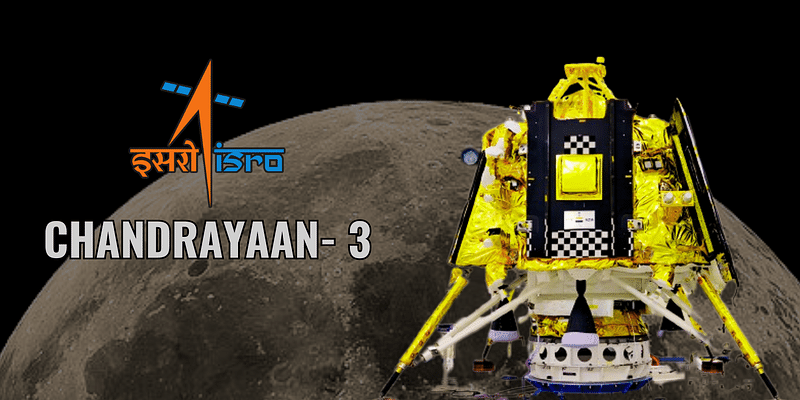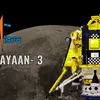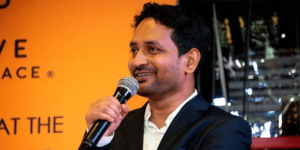
India is at the cusp of scripting history, as ISRO’s ambitious third Moon mission Chandrayaan-3’s Lander Module (LM) is all set to touchdown on the lunar surface on Wednesday evening, making it only the fourth country to do so, and first to reach the uncharted south pole of Earth’s only natural satellite.
The LM comprising the lander (Vikram) and the rover (Pragyan), is scheduled to make a touchdown near the south polar region of the Moon at 6:04 pm on Wednesday.
“The mission is on schedule. Systems are undergoing regular checks. Smooth sailing is continuing. The Mission Operations Complex (MOX) is buzzed with energy & excitement!” ISRO said on Tuesday, sharing visuals of the moon captured by cameras on the lander.
If the Chandrayaan-3 mission succeeds in making a touchdown on moon and in landing a robotic lunar rover in ISRO’s second attempt in four years, India will become the fourth country to master the technology of soft-landing on the lunar surface after the US, China, and the erstwhile Soviet Union.
<div class="tweet embed" contenteditable="false" id="1693879632481935555?ref_src=twsrc%5Egoogle%7Ctwcamp%5Eserp%7Ctwgr%5Etweet" data-id="1693879632481935555?ref_src=twsrc%5Egoogle%7Ctwcamp%5Eserp%7Ctwgr%5Etweet" data-url="https://twitter.com/isro/status/1693879632481935555?ref_src=twsrc%5Egoogle%7Ctwcamp%5Eserp%7Ctwgr%5Etweet" data-html="
Chandrayaan-3 Mission:
The mission is on schedule.
Systems are undergoing regular checks.
Smooth sailing is continuing.The Mission Operations Complex (MOX) is buzzed with energy & excitement!
The live telecast of the landing operations at MOX/ISTRAC begins at 17:20 Hrs. IST… pic.twitter.com/Ucfg9HAvrY
— ISRO (@isro) August 22, 2023
” data-type=”tweet” align=”center”>
Chandrayaan-3 Mission:
The mission is on schedule.
Systems are undergoing regular checks.
Smooth sailing is continuing.The Mission Operations Complex (MOX) is buzzed with energy & excitement!
The live telecast of the landing operations at MOX/ISTRAC begins at 17:20 Hrs. IST… pic.twitter.com/Ucfg9HAvrY
— ISRO (@isro) August 22, 2023
.thumbnailWrapper
width:6.62rem !important;
.alsoReadTitleImage
min-width: 81px !important;
min-height: 81px !important;
.alsoReadMainTitleText
font-size: 14px !important;
line-height: 20px !important;
.alsoReadHeadText
font-size: 24px !important;
line-height: 20px !important;

Chandrayaan-3 is a follow-on mission to Chandrayaan-2 and its objectives are to demonstrate safe and soft-landing on the lunar surface, roving on the Moon, and to conduct in-situ scientific experiments.
Chandrayaan-2 had failed in its lunar phase when its lander ‘Vikram’ crashed into the surface of the Moon minutes before the touchdown following anomalies in the braking system in the lander while attempting a landing on September 7, 2019. Chandrayaan’s maiden mission was in 2008.
The Rs 600 crore Chandrayaan-3 mission was launched on July 14 onboard Launch Vehicle Mark-III (LVM-3) rocket for a 41-day voyage to reach near the lunar south pole of the Moon. The soft-landing is being attempted days after Russia’s Luna-25 spacecraft crashed into the Moon after spinning out of control.
After the second and final deboosting operation on August 20, the LM is now placed in a 25 km x 134 km orbit around the Moon.
The module will undergo internal checks and await the sunrise at the designated landing site, ISRO said, adding that the powered descent–to achieve soft landing on the Moon’s surface–is expected to be initiated at around 5:45 pm on Wednesday.
ISRO’s Space Applications Centre Director Nilesh Desai said, “If any health parameter (of the lander module) is found abnormal on August 23, then we will delay the landing by four days to August 27.”
The critical process of soft-landing has been dubbed by many, including ISRO officials, as “17 minutes of terror”, with the entire process being autonomous when the lander has to fire its engines at the right time and altitudes, use the right amount of fuel, and scan of the lunar surface for any obstacles or hills or craters before finally touching down.
After checking all the parameters and deciding to land, ISRO will upload all the required commands from its Indian Deep Space Network (IDSN) at Byalalu, to the LM, a couple of hours before the scheduled time touchdown.
According to ISRO officials, for landing at around 30 km altitude, the lander enters the powered braking phase, and begins to use its four thruster engines by “retro firing” them to reach the surface of the moon, by gradually reducing the speed. This is to ensure the lander doesn’t crash, as the Moon’s gravity will also be in play.
ISRO officials also noted that on reaching an altitude of around 6.8 kilometers, only two engines will be used, while the other two will be shut down to give a reverse thrust to the lander as it descends further. On reaching an altitude of about 150-100 metres, the lander, using its sensors and cameras, will scan the surface to check whether there are any obstacles, and then start descending to make a soft landing.
ISRO Chairman S Somanath recently said the most critical part of the landing will be the process of reducing the velocity of the lander from 30 kilometer height to the final landing, and the ability to reorient the spacecraft from horizontal to vertical direction.
“This is the trick we have to play here,” he said.
Instead of a success-based design in Chandrayaan-2, the space agency opted for a failure-based design in Chandrayaan-3, focusing on what can fail, how to protect it, and ensuring a successful landing, the ISRO chief said.
After the soft landing, the rover will descend from the lander’s belly onto the Moon’s surface using one of its side panels, which will act as a ramp. The lander may have to face the challenge of lunar dust due to the firing of onboard engines close to the lunar surface.
The lander and rover will have a mission life of one lunar day (about 14 earth days) to study the surroundings there. However, ISRO officials do not rule out the possibility of them coming to life for another lunar day.
(This story has been edited for context and length.)
Edited by Megha Reddy










